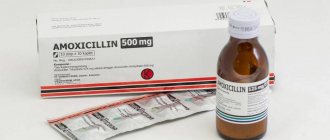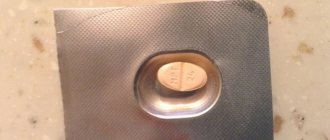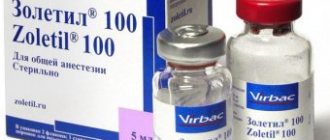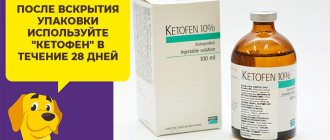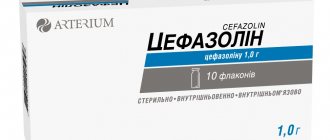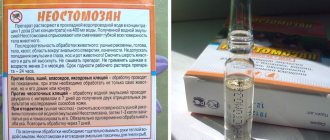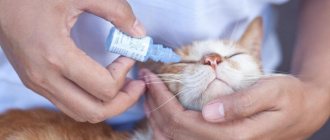Indications for use, dosage and method
The drug is prescribed for bacterial infections and inflammatory processes:
- upper and lower respiratory tract;
- joints;
- genitourinary organs;
- skin, hooves, soft tissues;
- gastrointestinal tract;
- metritis - mastitis - agalactia of sows;
- umbilical infections;
- for the prevention of complications during surgical interventions;
- other bacterial and inflammatory diseases.
The therapeutic dose is calculated depending on the weight of the animal. It is 1 ml for every ten kg of weight, which corresponds to 15 mg of the active substance. Once in the animal's body, amoxicillin destroys the membranes of pathogenic microorganisms, causing their death.
Intramuscular injections are more effective for farm animals. For domestic pets such as cats and dogs, intramuscular and subcutaneous administration is acceptable. Shake the bottle well before use. Repeated administration is possible only after 48 hours.
Form, composition
Suspension for injection from white to light yellow; During storage, separation of the suspension is allowed, which disappears when shaking.
| 1 ml | |
| amoxicillin trihydrate | 150 mg |
Excipients: butylated hydroxytoluene, anhydrous colloidal silicon dioxide, triglycerides of saturated fatty acids.
Packaged in 20, 50, 100 and 250 ml in glass bottles of appropriate capacity, sealed with rubber stoppers, reinforced with aluminum caps with tamper evident clips. Each consumer package is supplied with instructions for use.
Pharmacological properties
Amoxicillin 15% belongs to the antibacterial drugs of the group of beta-lactam antibiotics.
Amoxicillin trihydrate, which is part of the drug, has a wide spectrum of antibacterial action, is active against gram-positive and gram-negative microorganisms, including Escherichia coli., Salmonella spp., Pasteurella spp., Clostridium spp., Staphylococcus spp., Streptococcus spp., Haemophilus spp., Corynebacterium spp., Actinomyces spp., Bacillus anthracis, Erysipelothrix rhusiopathiae, Listeria monocytogenes, Pasteurella spp., Proteus mirabilis, Leptospira spp., Moraxella spp., Actinobacillus spp..
The mechanism of the bactericidal action of amoxicillin is to disrupt the synthesis of mucopeptide, which is part of the cell wall of microorganisms, by inhibiting the enzymes transpeptidase and carboxypeptidase, which leads to disruption of the osmotic balance and destruction of the bacterial cell.
Amoxicillin trihydrate is well absorbed from the injection site and is quickly distributed in the animal’s body, the maximum concentration of the antibiotic in the blood is reached 1-2 hours after administration of the drug and remains at a therapeutic level for 48 hours.
The antibiotic is excreted from the body mainly with urine and partly with bile, mostly in unchanged form.
Contraindications
- Hypersensitivity to the components of the drug (including other penicillins, cephalosporins, carbapenems),
- allergic diseases (including a history),
- bronchial asthma,
- hay fever,
- Infectious mononucleosis,
- lymphocytic leukemia,
- liver failure,
- colitis associated with the use of antibiotics, including a history of
- lactation period,
- children under 10 years of age weighing less than 40 kg.
Amoxicillin (15%) (Amoxicillin 15%)
Composition and release form: Amoxicillin oil suspension for injection is a suspension, 1 ml of which contains 150 mg of the antibiotic amoxicillin in the form of trihydrate. In appearance it is a white liquid. Amoxicillin suspension is produced sterilely, packaged in glass bottles with a capacity of 100 ml, hermetically sealed with rubber stoppers and rolled with aluminum caps. Pharmacological action: Amoxicillin is a semi-synthetic antibiotic from the penicillin group, active against gram-positive and gram-negative microorganisms, including Escherichia, Salmonella, Pasteurella, Clostridia, Staphylococcus, Erysipelothrix, Hemophilus, Bordetella, Corynebacterium and Microplasma. When administered parenterally, the antibiotic is well absorbed into the blood from the injection site and penetrates into all organs and tissues of the body. Amoxicillin is excreted mainly in the urine and in small quantities in the bile. Indications: Amoxicillin 15% oily suspension for injection is used to treat bacterial infections of the gastrointestinal tract (including enteritis, gastroenteritis, enterocolitis), respiratory diseases (including bronchitis, bronchopneumonia, rhinitis), surgical infections (including abscesses, inflammation of the joints), genitourinary diseases systems (including metritis, endometritis, cystitis, urethritis, pyelonephritis) and other infections of farm animals, dogs and cats caused by microorganisms sensitive to amoxicillin. Doses and method of administration: the drug is administered to animals intramuscularly or subcutaneously at intervals of 24 hours for 3-5 days. Cattle and sheep – 7-11 mg/kg body weight; pigs – 7-15 mg/kg body weight; dogs and cats – 7 mg/kg body weight, which corresponds to one head per day: cattle (450 kg body weight) – 20-30 ml; sheep (65 kg) – 3-5 ml; pigs (150 kg) – 7-15 ml; dogs (20 kg) – 1 ml; cats (5 kg) – 0.25 ml. Side effects: Animals may have allergic reactions to amoxicillin, which quickly disappear after stopping use of the drug. If allergic reactions occur, it is advisable to administer antihistamines and corticosteroids to animals. Contraindications: Amoxicillin is not used for infections caused by penicillinase-forming microorganisms. The drug is not administered to rodents. Amoxicillin is not suitable for intravenous administration. Amoxicillin should not be mixed with other drugs in the same syringe, nor should it be used simultaneously with bacteriostatic chemotherapeutic agents. Special instructions: Slaughter of animals for meat of cattle, sheep and pigs is permitted no earlier than 14 days after stopping the administration of amoxicillin. The meat of animals forcedly killed before the expiration of the specified period can be used to feed fur-bearing animals or for the production of meat and bone meal. Milk from animals that have been administered amoxicillin can be used for food purposes 2 days after the end of treatment. Milk obtained from animals during the period of amoxicillin use and until 2 days after the last administration of the drug is used for feeding animals. Storage conditions: Amoxicillin is stored with caution in a place protected from light at a temperature of 15-18 C. The guaranteed shelf life of the drug under the specified storage conditions is 3 years. Manufacturer KRKA, Slovenia.
Indications and contraindications
If you follow the instructions for use, Amoxicillin is prescribed for certain cattle diseases.
Infections:
- Gastrointestinal tract (diarrhea, salmonellosis, enteritis, colibacillosis);
- respiratory tract (pneumonia, rhinitis, bronchitis);
- genitourinary system (vaginitis, cystitis, metritis, leptospirosis);
- soft tissues, skin and hooves (abscess, arthritis, necrobacteriosis);
- joints.
Amoxicillin is also used to treat umbilical infections, atrophic rhinitis, mastitis and to prevent postoperative surgical infections caused by microorganisms that may be sensitive to Amoxicillin.
The only contraindication to the use of this antibiotic may be the individual hypersensitivity of a particular animal to antibiotics belonging to the penicillin group.
Doses and method of administration of veterinary amoxicillin
This drug is given to animals intramuscularly or subcutaneously in a dose of 1 milliliter per 10 kilograms of animal weight, that is, 15 milligrams of the substance per 1 kilogram of body weight. If the animal has renal failure, then precise adjustment of the dose of the drug is necessary. The contents of the bottle must be shaken thoroughly before use to obtain a homogeneous suspension. If necessary, the drug can be re-administered after two days. If the dose of the drug exceeds 20 ml, then it must be administered in several injections and in different places. After this, it is recommended to massage the injection site.
Methods of administration and dosage
The drug is administered intramuscularly or subcutaneously. The injection is carried out with a dry syringe and wiped hands, because moisture inactivates the antimicrobial effect of the drug. The animal's condition is assessed two days after the injection; if necessary, the antibiotic is repeated. Amoxicillin 15 should not be mixed with other drugs.
The medicine is produced by several pharmacological companies from different countries - Spain, Czech Republic, Slovenia, Russia. Each manufacturer describes its own recommendations on dosages, restrictions, and methods of storing the drug.
Amoxicillin is effective against erysipelas in pigs
Side effects
May include allergic skin reactions (skin scratching, redness, swelling at the injection site). When these symptoms appear, antihistamines and corticosteroids are prescribed.
No side effects from an overdose of the drug were detected in healthy animals. The exception is animals with liver and kidney diseases (for them, careful dosage adjustment is recommended).
Contraindications
There are a number of restrictions:
- The use of the drug is acceptable for all animals. However, the exception is pets with individual intolerance to this antibiotic. In this case, it is recommended to change the medicine.
- Contraindicated for use in pregnant and lactating animals (due to the ability to penetrate the placenta).
- It is prohibited to mix with other agents (antibiotics, bacteriostatics) in a common syringe.
- Cannot be used to treat rodents (rabbits, rats, guinea pigs, hamsters, gerbils) or small animals.
- Cannot be administered intravenously.
special instructions
The slaughter of animals for meat for food is permitted after 2 weeks from the date of the last administration of the drug. When slaughtered before this period, it is allowed to feed meat or meat and bone meal to other animals.
Drinking milk is allowed after 2 days from the date of stopping the administration of the antibiotic. Milk taken before this period is allowed for watering other animals.
Amoxicillin is not compatible in a shared syringe with any other drugs. Combination with penicillins, bacteriostatic drugs, cephalosporins, and fluoroquinolones is prohibited.
Analogs
There are the following analogues of Amoxicillin for animals:
- Amoximag – 15% solution for injection;
- Amoxisan - bottles of 10, 20, 50, 100, 250 ml;
- Amoxilong 150 LA – 15% solution, 100 ml, valid for 48 hours;
- Amoxoil Retard - for the treatment of large and small livestock;
- Clamoxyl LA – contains aluminum salt of stearic acid;
- Vetrimoxin LA - for the treatment of cows, goats, sheep, pigs.

